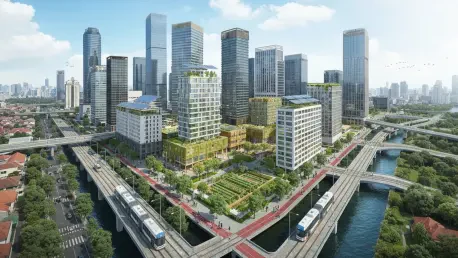Jakarta, the vibrant capital of Indonesia, stands as a testament to the rapid urbanization sweeping across Southeast Asia, yet it grapples with significant challenges such as crippling traffic congestion, environmental degradation, and overpopulation. Amid these struggles, a remarkable shift is underway, driven by innovative projects that prioritize sustainability and smart technology. One of the most striking examples is the collaboration between Johnson Controls, a global leader in building solutions, and Thamrin Nine, a sprawling multi-purpose complex in the heart of Jakarta’s central business district. This partnership is not merely about erecting structures but about reimagining urban spaces to meet modern demands while safeguarding the environment. The Thamrin Nine development, home to the Autograph Tower—the tallest building in the Southern Hemisphere—and the Luminary Tower, symbolizes a new era for Jakarta. It offers a compelling vision of how sustainable urban planning can address pressing issues, paving the way for a greener, smarter future for the city’s millions of residents.
Innovating with Smart Building Solutions
The transformation of Jakarta’s urban landscape hinges on the integration of cutting-edge technologies, with Johnson Controls leading the charge through its partnership with Thamrin Nine. Their expertise in sustainable building systems has introduced advanced tools like the YORK cooling units and the Metasys Building Management System to the complex. These innovations are designed to optimize energy consumption, achieving savings of up to 30 percent compared to conventional setups. Such reductions are vital in a city like Jakarta, where energy demands continue to escalate with population growth and urban expansion. By focusing on efficiency, these technologies not only lower operational costs for building managers but also significantly cut down on carbon emissions, aligning with global sustainability goals. This approach demonstrates that large-scale developments can thrive without compromising environmental responsibility, setting a powerful example for other urban projects in densely populated regions.
Beyond energy efficiency, the smart systems deployed at Thamrin Nine emphasize real-time monitoring and data analytics to maintain optimal performance. This proactive strategy ensures that potential issues are identified and resolved before they escalate, minimizing downtime and reducing long-term maintenance expenses. Occupant comfort remains a priority, with tailored solutions addressing the diverse requirements of the complex’s commercial, residential, and retail spaces. The concept of a “city within a city” comes to life as these technologies create seamless environments where functionality and sustainability coexist. For Jakarta, a metropolis often strained by infrastructure challenges, such advancements offer a blueprint for balancing urban growth with livability. The impact of these systems extends beyond immediate benefits, fostering a model of development that other cities in the region can adapt to their unique needs, proving that technology can be a cornerstone of sustainable progress.
Setting New Environmental Standards
A hallmark of the Thamrin Nine project is its commitment to environmental excellence, evidenced by the prestigious BCA Green Mark Platinum certification it has earned. This recognition is no small feat, as it signifies adherence to rigorous sustainability standards that prioritize energy efficiency, waste reduction, and eco-friendly design. In a city like Jakarta, where pollution and resource strain are persistent issues, such achievements highlight the potential for urban developments to contribute positively to environmental goals. The certification also aligns with Indonesia’s ambitious target of achieving Net Zero Emissions by 2060, showcasing how private initiatives can support national agendas. This milestone serves as a benchmark for other developers in the region, proving that high standards of environmental responsibility are attainable even in large-scale, multi-use projects.
The environmental focus at Thamrin Nine goes beyond accolades, embedding green practices into every facet of the complex’s design and operation. From advanced cooling systems that reduce energy demand to building automation that optimizes resource use, the project tackles Jakarta’s ecological challenges head-on. These efforts are particularly critical in a tropical climate where cooling needs are constant and energy-intensive. By integrating such technologies, the development not only lowers its carbon footprint but also enhances the quality of indoor environments for occupants. This dual benefit—environmental and human-centric—underscores the broader significance of sustainable urban planning. As Jakarta continues to grow, projects like this offer a replicable model for mitigating the environmental impact of urbanization while ensuring that new developments contribute to a healthier, more sustainable cityscape for future generations.
Reimagining Urban Lifestyles
The Thamrin Nine development transcends traditional construction by embodying a visionary approach to urban living that integrates sustainability with functionality. Project leaders have articulated a goal to create a destination that combines vast scale with eco-conscious design, offering a mix of commercial, hospitality, retail, and residential spaces within a single hub. This integrated model addresses Jakarta’s pressing need for multi-functional spaces that alleviate pressure on existing infrastructure. By consolidating diverse services and amenities, the complex reduces the necessity for extensive commuting, thereby easing traffic congestion—a chronic issue in the capital. Such a design not only enhances convenience for residents and visitors but also elevates the overall quality of life in an urban setting often marked by chaos and overcrowding.
Furthermore, the emphasis on sustainability within this urban hub redefines how Jakartans interact with their environment. The incorporation of green technologies ensures that daily activities, whether working in office towers or shopping in retail zones, occur in spaces designed for minimal environmental impact. This shift fosters a culture of eco-awareness among occupants, encouraging sustainable habits in a city where such practices are increasingly necessary. The project’s holistic approach also serves as a catalyst for broader urban renewal, inspiring similar developments to prioritize both human well-being and planetary health. As Jakarta evolves, initiatives like Thamrin Nine illustrate the transformative power of blending modern lifestyles with responsible design, creating environments where people can thrive without sacrificing the city’s ecological future. This reimagining of urban spaces offers hope for a more balanced and harmonious metropolitan experience.
Inspiring Regional Progress
The influence of the Thamrin Nine collaboration reaches far beyond Jakarta’s borders, positioning it as a pioneering model for sustainable urban development across Southeast Asia. Johnson Controls’ proven track record in the region, with successful implementations at locations like the Mactan-Cebu International Airport in the Philippines, demonstrates the versatility of their sustainable solutions across varied contexts. These projects highlight how global expertise can be tailored to address local challenges, from energy demands in tropical climates to the unique needs of mixed-use developments. For rapidly urbanizing areas in the ASEAN region, the Thamrin Nine initiative provides a tangible example of how technology and vision can converge to create smarter, greener cities that prioritize long-term sustainability over short-term gains.
Equally important is the project’s role in supporting regional environmental aspirations, such as Indonesia’s commitment to significant emission reductions in the coming decades. By showcasing measurable outcomes like substantial energy savings and top-tier certifications, the collaboration between Johnson Controls and Thamrin Nine offers a replicable framework for other cities grappling with similar urbanization pressures. This scalability is crucial in a region where population growth often outpaces infrastructure development, leading to environmental and social strain. The success in Jakarta can inspire policymakers and developers across Southeast Asia to adopt similar strategies, fostering a collective movement toward urban centers that are not only economically vibrant but also ecologically sound. As such, this project stands as a beacon of progress, illuminating the path for regional transformation through sustainable innovation.
Building a Legacy of Sustainability
Reflecting on the strides made through the Thamrin Nine project, it’s evident that sustainable urban development has left an indelible mark on Jakarta’s skyline and ethos. The integration of smart technologies by Johnson Controls, paired with the visionary design of the complex, has established a new standard for what urban spaces can achieve in terms of energy efficiency and environmental stewardship. The BCA Green Mark Platinum certification earned during this endeavor highlights a commitment to excellence that resonates throughout the city, proving that ambitious environmental goals are within reach even for sprawling developments.
Looking ahead, the legacy of this collaboration provides actionable insights for future projects in Jakarta and beyond. Developers and city planners can draw from this model to prioritize green technologies and integrated urban planning, ensuring that new constructions contribute to sustainability targets. Policymakers might consider incentives for similar initiatives, fostering an environment where eco-friendly development becomes the norm. As the region continues to urbanize, the lessons learned from Thamrin Nine can guide the creation of cities that harmonize growth with ecological balance, securing a healthier future for all.









